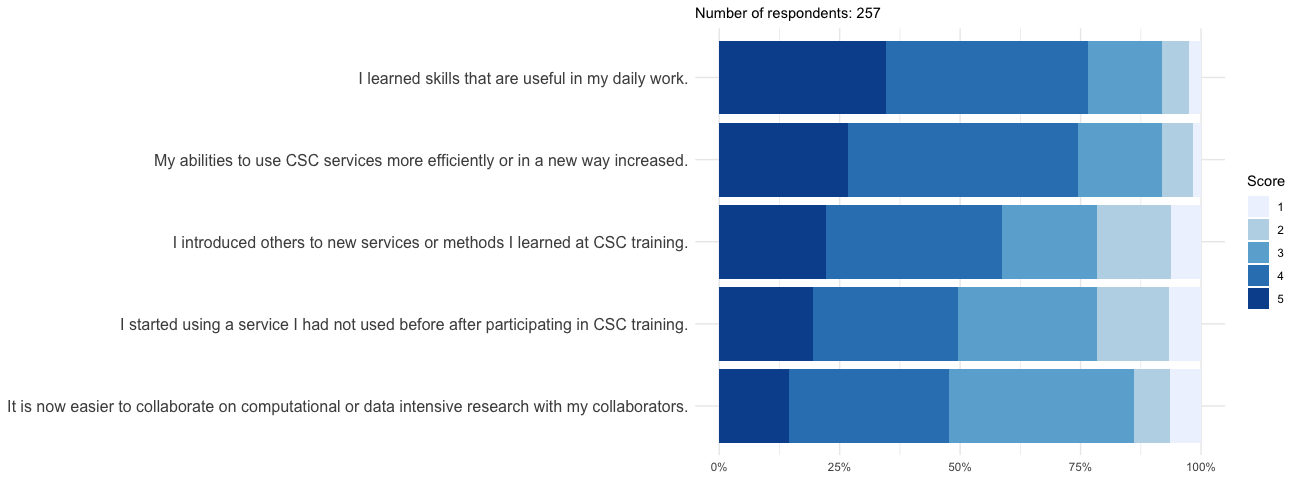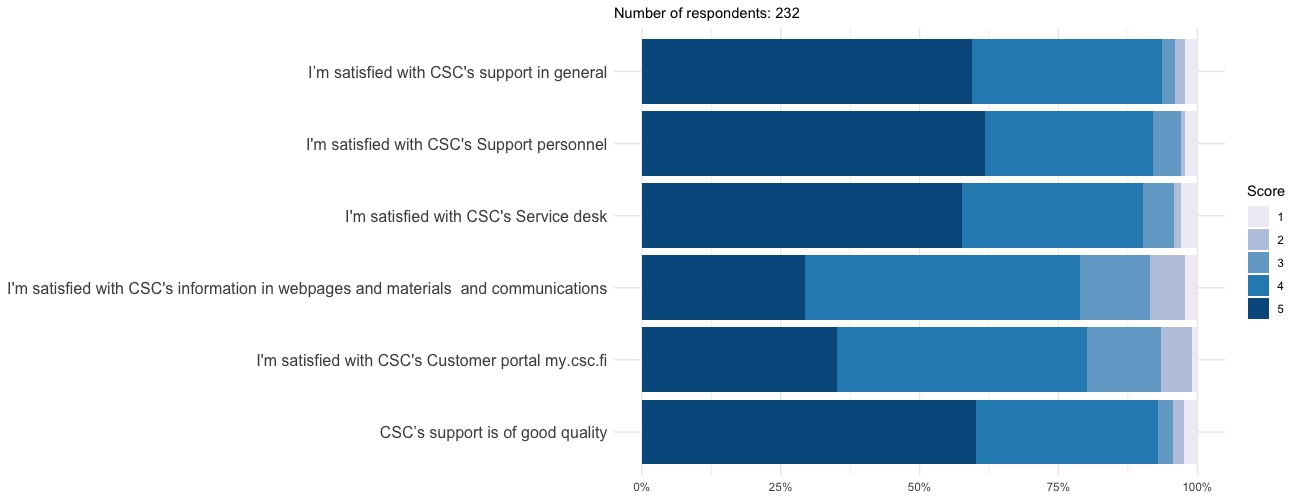The programme was not only about investment on new infrastructure but also on developing competences and capabilities to use the services effectively. There are some fields, e.g. physical and chemical sciences, where researchers are familiar with using high-performance computing in their daily work. Besides benefitting the more traditional fields, the DL2021 programme was to enable effective use also in research fields that are not that experienced with using computing services. Also, opening the services for the governmental research institutes brought a new user group to CSC's services. It was essential since the beginning that with support and training it is possible to ensure effective use of the services.
4.1 Effective use with training
To ensure effective use of the new infrastructure, also for new users, CSC organised a campus tour around Finland in 2019 introducing the services that it offers for data management and computing. The tour had about 500 participants attending the introductory training events in 13 campuses and research institutions in major university cities in Finland. The events arranged had a general CSC services focus, or sometimes also a specific research area focus, such as biosciences and machine learning.
Since March 2020 all training events has taken place as webinars or online trainings, which has enabled larger audiences around Finland. Altogether in 2018–2021 CSC has organised 370 training related events totalling 14 500 participants or interactions with customers. The customer feedback has generally been very positive, average score for the trainings being 8,7/10.
The user survey results from 2020 show that CSC's trainings offers useful skills and practises for everyday work and help customers to use the infrastructure in a more effective way (Figure 4.1). To advance the effective use of systems, in 2021 CSC has also organised training courses on the theme of "Efficient use of CSC's services". These trainings attracted about 165 participants altogether.
Figure 4.1. Benefits of training's organised by CSC.
We asked: Below there are some statements regarding CSC’s trainings. Please, assess them according to your experience.5= strongly agree,4= agree,3= neither agree nor disagree,2= disagree,1= strongly disagree,IDK= I don't know. In total, 257 respondents (187–246 per statement, IDK responses are not included in the figure).
Data source: Survey for users of CSC's data management and computing services 2020.
4.2 Improved documentation and support to facilitate the use
One of the goals for the programme was to strengthen the national and facilitate local expert support so that they are able to scale with increasing number of users and entry of research institutes. One way to enable scaling the support was to offer on-site support during 2019 at some of the campuses, especially at governmental research institutes. In general, the experiences of the on-site support was very positive both for CSC and for the organisations. For CSC's experts it offered a way to gain more understanding of the researchers' work and challenges. The researchers had a chance to get support directly at their workplace, and the local expert support increased their knowledge on CSC's services. Ideally, CSC's services would be seen as a natural extension for the local services in cases when it is meaningful to use national computing and data management infrastructure. Based on the results of the user survey 2020, CSC's services complement the local services but CSC's services are also necessary for the usrer's work. There may not always be enough computing capacity (CPU or GPU), storage capacity or needed services available locally. The DL2021 programme has enabled offering these centrally for the use of research and higher education institutions. As a whole, the service offering consisting of organisation's IT and CSC's service offering is sufficient, based on the survey results in 2021 (view of about 85% of the respondents).
CSC has renewed its platform for user guides to use Github, MkDocs and Rahti to enable more effective collaboration inside CSC between its different units and functions, automatic testing and involving also external users into development. Based on the received user feedback, this has been complemented with tutorials, courses and self-study material. Recent feedback from the user survey 2021 regarding support, documentation and communication is presented in Figure 4.2.
Figure 4.2. User experience on support, communications and information.
We asked: Below there are some statements regarding support, communications and information related to your CSC customership and service usage. Please, assess them according to your experience. 1= strongly disagree, 2= disagree, 3= neither agree or disagree, 4=agree, 5=strongly agree, IDK= I don't know. N=232 (165–217 per statement, IDK answers are not included in the figure).
Data source: Survey for users of CSC's data management and computing services 2021
4.3 Automated processes enable scaling
During the programme, in 2018–2021, the amount of users of CSC's services has grown over 40% (Figure 2.1 in section 2). As the users, resources and services have considerably increased, subsequently also the demand. To cope with the increasing demand, resource applications have been categorized into three sizes according to different needs: S (100 00 billing units, BUs), M (1 000 000 BUs), and L (over 1 000 000 BUs). Resource applications are included in the user portal, MyCSC. In the same time also the usage of data services such as Allas and the disk areas in Puhti and Mahti started to be counted in billing units. Projects that need only minor computational or data capacity S size applications will suffice, and these will be accepted automatically with a check afterwards. Handling of data quotas of Puhti and Mahti was also automatized and included in MyCSC. CSC's Resource allocation group accepts resource and data applications and follows the use of resources. The number of resource applications has grown from 801 applications in 2018 to 1 474 applications in 2020 and up to 1 770 applications in 2021 by November. Nevertheless, this high amount still needs considerable interaction with the users that cannot be automatized. The growth in applications was also facilitated by the upgraded easy-to-use user portal, MyCSC.
Next chapter: 5. Conclusions

